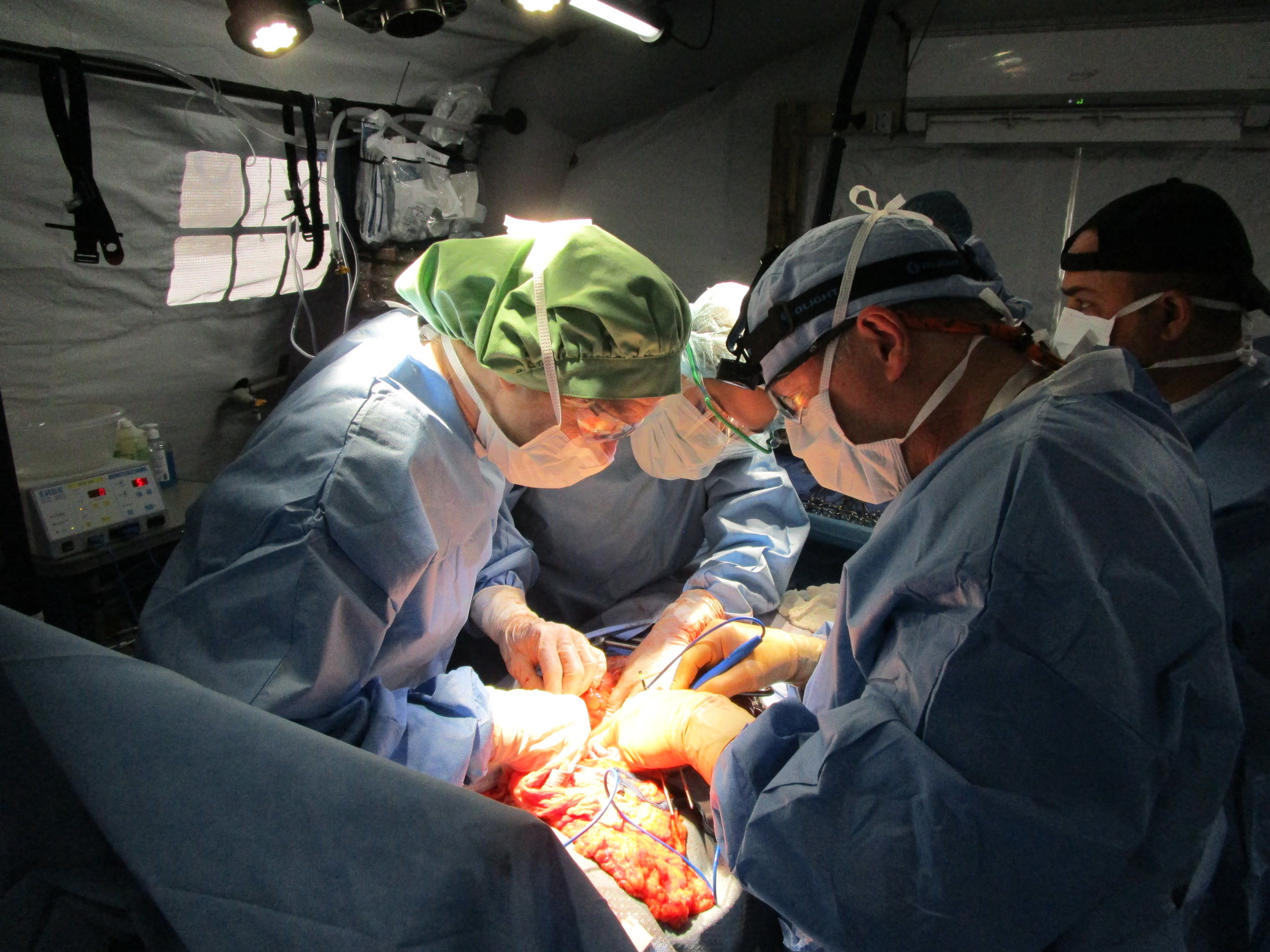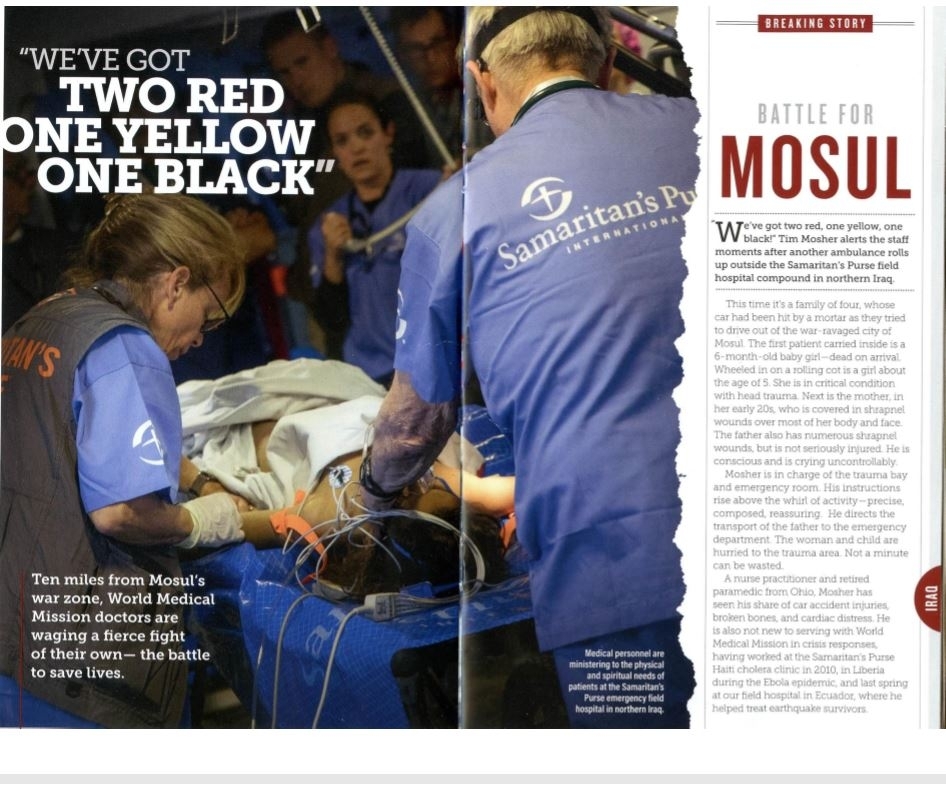Iraq

Mission Mosul.
Ten miles from Mosul's war zone, Pat works to save lives with the team of World Medical Mission doctors. This is her story.
the journey begins…
"On Friday, March 17, 2017, the Samaritan’s Purse Emergency Field Hospital received its 1,000th patient on the Plains of Nineveh, Iraq. Due to its proximity to the frontlines of the Mosul conflict, the hospital is saving lives that would likely have been lost in transport to the nearest permanent medical facilities, up to two hours away." [Samaritan's Purse International Relief}
4/12/2017
Early in the morning Fenton takes me to the airport. I know that he is worried about me--he has seemed much more nervous this time as I prepared to go than I have ever seen him. I have heard him say things to others at church as they have said goodbye to me that lets me know he is concerned, yet he is here beside me, carrying my bag, and waiting in line with me as I arrange my ticket and for my bag to be tagged for Iraq. The airline check-in gal says, "You are brave" as she gives me my ticket. I enter the security line, Fenton holds me and we pray together one more time before that last kiss and a wave and I am off. It is hard for me to see him go. I worry about him, also. I know that I have "hidden gifts" for Easter for his 65th birthday that I will miss. I have baked treats and individually packaged each one with a Scripture verse and an encouraging word. There is enough for one day until my planned return. He has my Samaritan's Purse email address and the numbers of all contact people as well as my flight reservations all tacked to the door of the refrigerator. I feel this is the Lord's will. I have been prayed for and I have read all the papers and taken all the security testing that Samaritan's Purse has sent. I am as ready as I can be.
Scroll down to read Pat's entire story and view images from her trip in the photo gallery below.
Thank you for your prayers!
Thank you for praying for safety during my time in Iraq, for comfort during the lonely times (both for Fenton and me), and that my time there was profitable for God's kingdom.

"Insecurity Course"
"Insecurity Course" is what we laughingly call the day of telling you about the possible dangers you may face and what the security people are doing for them. It was scary enough at home when we took the UN online security training, then to sit and listen as the instructor tells you about different kinds of ordnances, where they have been found, that the road is still marked by it and if you want to see them just look for the red flags.
We walk away knowing that we are in an insecure world but strongly feel we have physically been made as secure as possible by the Iraqi Security Forces, the private security forces, and the hospital guards. More than that, we again feel that we are in the Lord's hands and in His will. Can there be a better place?
Traveling the open road.
On the open road to the Erbil Field Hospital. The two hour trip included four checkpoints, some highway, lots of broken roads from IEDs, diversions around blown bridges and four IDP (Internally Displaced Persons) camps.
IDP Camps Off in the Distance
12,000-20,000 people were living in the Internally Displaced Persons camps during this time where the desert is cold at night and hot during the day.
One or two families will live in a tent with multiple families sharing toilets and showers. There is a limited water supply and only rice and beans are provided. Most experience severe emotional trauma before they arrive and now face a difficult living situation and an uncertain future.

Graveyard outside of village
A testimony to the greatest cost of war.
Emergency Field Hospital Staff
The infrastructure, equipment, and staff are all outstanding.
The Emergency Field Hospital Staff is supported by an amazing security staff of private security forces and guards in each tent.

Choosing Compassion over Fear
The volunteers are all well staffed, organized, and informed.
The food, sleeping sites, toilets, showers, and temperature controls were all optimal considering the hospital was in a tent!

Services Available
EMT assessed and disrobed patients to ensure no hidden munitions. The triage nurse color coded the patient level. Two general surgeons and one orthopedic surgeon were always there on site. The operating room was full staffed with techs and nurses and a sterilizing unit. The recovery area--ICU--Step-down--Male/Female/Children's wards were all staffed and supplied.

Sniper Wound Care
Small children who are playing or running with family across an area that is unsafe are often the targets of snipers. The snipers aim for the thigh and so it is not uncommon to find a large fragment in the area of the bone. The unsuspecting child will immediately become helpless and cry for help. The adults in the area know that the child is now bait and that the snipers are waiting for the adults to come rescue the pleading child. The adults are now the true target. Rescuing a child from a sniper brings almost certain death.

X-ray of Femur with bullet
Snipers shoot to immobilize their targets and most often moderately or severely wound their victims.
The femur wound with the shattered bone is opened, cleaned, any shards and fragments of metal and debris removed, and external fixitors placed on the bone.
It is not an ideal fix but with so much bone loss and the inevitable large and dirty wound, it is the best that can be done. The child will be maimed for life.

Sniper bullet
Sniper bullet removed from femur of a young patient.

Orthopedic Surgery
Caring for wounds associated with multiple fractures that were mostly externally fixated by an orthopedic surgeon.

Abdominal and Chest Wounds
Caring for some abdominal and chest wounds from mostly IEDs, fewer direct gun shot wounds.

Skin Grafts
Skin grafts for wounds and burns.

Training
Help to train national staff so that they can take over the EFH.

Dad and Daughter Healing Together
Both this dad and his daughter are patients receiving care at EFH.
Working with the famous
Dr. Kent Brantly was working at EFH. We are holding up a sign to say hello to a mutual friend who is a doctor in Africa.
Kent is the doctor who contracted and recovered from the Ebola virus in 2014 in Liberia while working as a Post-Resident physician with World Medical Mission. Read his story here.

... and another famous one
The surgeon I am assisting is Paul Osteen (Joel Osteen's brother) who had originally operated on this ER patient. He is the hospital director and the most humble, gentle, and compassionate surgeon I think I have ever met.

... and those who SHOULD be famous!
Working with the dedicated staff at EFH.

Operating Room View
Operating Room view from the central Operating Room core.

Wound care
Shrapnel from IEDs (Improvised Explosive Device) can cause a huge amount of tissue damage from just a small fragment.

X-ray of shrapnel in hand

Care of shrapnel wounds
If the metal is deep and the wound able to heal without removal (and additional tissue damage), we will leave the piece intact. Other times it stays in the base of the wound as a source of a chronic infection. You cannot always tell which way it will go at the time of the acute injury. In this hand, we found and removed the piece of metal.

Touring Erbil
A break from the EFH to go to the city was mandatory if you worked there for more than three weeks.
I ventured out with my friend, Hannah, and a male translator. Our time in town proved to be interesting, exciting, and a wonderful time together.

Taking a Rest
Erbil is a beautiful city. Both ancient and modern.
Erbil Citadel
Oldest continuous occupied site in the world. It has been occupied since the 5th century B.C..
Read more about the Erbil Citadel here.

Erbil Street Musician and Vendor

Erbil Musical Instruments

Erbil Marketplace

Berries

Produce

Modern Erbil in the Distance
The Citadel "Qalat"
The Citadel is known as Qalat to the locals.

An ancient city
Imagine life in the past on these narrow streets.
Overlooking Erbil City Square
Erbil is the capital and largest city of the Kurdistan region in northern Iraq and is 220 miles north of Baghdad.

Erbil Traditional Dress
Our translator pointed out these young ladies and mentioned that this was very traditional dress for the Erbil area. We were noting all the details of their dresses and he walks up and asks them if they will allow us to take their picture. They crowd in right next to us and pose with big smiles. It was only later that we realized they were part of the afternoon featured entertainment of regional folk dancers. It was fun to meet them and then to watch them dance.

Erbil Folk Dance
There were multiple groups of cultural dancers. This kind of entertainment I would expect to attract many women, but only men were standing by the stage. A large group of women, all covered, were standing at a distance with one older man.

Road signs
I have NO idea where these signs say we are standing but we are enjoying every moment of the adventure.

The staff
Saying goodbye to the staff at EFH. Keeping hope alive!
My journey is over but the work continues.
5/21/2017
And so my time at EFH ends.
After I left, the original mandate from the UN had been to do emergency care only through June 31, 2017. In early May, the mandate was expanded to include urgent care of the IDP camps east of the hospital. On September 28, 2017, Samaritan's Purse officially handed over the hospital to the Iraqi Ministry of Health, a partner in this project since its inception. The work continues.
To find out more about how you can help, read Northern Iraq Remains In Critical Need.
If you would like to contact Pat to find out more details about this trip or any upcoming medical missions trips, complete the contact form below.








